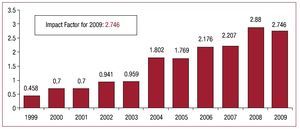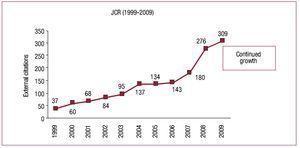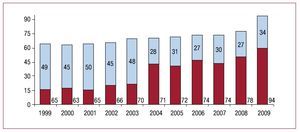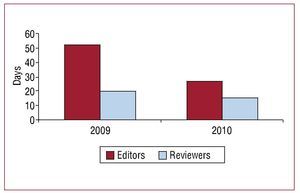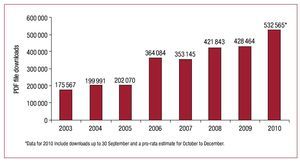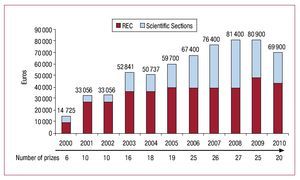Traditionally, scientific journals present a summary of the previous 12 months' activity in the final issue of each year. Thus, they keep subscribers and readers in general up to date with results, innovations and actions taken in the year that is ending. Revista Española de Cardiología (REC) has long published reports like this,1-3 and the new editorial team intends to continue the tradition. In this article we offer the bibliometric data, a summary of various activities, and initial results of the new initiatives we described in our initial presentation.4 The current report was presented and debated in detail with the Editorial Committee and Editorial Board during their annual meeting, which coincided with the Congress on Cardiovascular Diseases in Valencia. Furthermore, part of the information was distributed to the plenary session of the Spanish Society of Cardiology (SEC), when the Scientific Sections and all members at the General Assembly were informed.
Bibliometric Data
In June, the well-known Impact Factor (IF) index was published for 2009. Calculated by the Institute of Scientific Information (ISI) and published in Journal Citation Reports, the IF reflects the number of citations received in 2009 for articles published in 2007 and 2008. In 2009, our IF was 2.746, which is slightly down on the previous year's 2.88. However, from an editorial point of view, small swings— measured in decimal points—are a normal part of a journal's progress. Figure 1 shows how REC's IF has evolved since it was first calculated in 1999. Despite the slowdown that the 2009 IF represents, we want to point to the growing number of external citations (309), and corresponding fall in self-citations. This is an increasingly important parameter and will gain weight in the evaluation of scientific publications because external citations are an unequivocal sign of the interest and dissemination of a journal in the international community. Figure 2 shows the favorable evolution of our external citations. The immediacy index, reflecting citations received in the year of publication, was 0.675. The mean life of these citations is 3.8 years.
Figure 1. Time trend in the impact factor since 1999.
Figure 2. Trend in the number of external citations received by Revista Española de Cardiología. Expressed in terms of the number of external citations received each year by articles published in the previous 2 years.
This year has seen a spectacular, totally unprecedented increase in the number of cardiovascular publications indexed by the ISI. From 78, the total has risen to 94 journals: a 20% increase in just 1 year (Figure 3). Most of the new publications are affiliate journals of the major publishers in cardiology and focus on sub-specialties. Despite the much more competitive scenario we have witnessed in 2009, REC has comfortably held its position in the second quartile. This extraordinary level of competition has yet to end because at least another 10 journals are awaiting their first IF. These are English-language publications, which often receive manuscripts in sub-specialties referred to them directly by their parent journals. They will progress rapidly, as has happened this year when some journals received a first IF of >2.5. Clearly, REC faces an extraordinary challenge to maintaining the high bibliometric standard it has achieved in recent years. However, through the quality of the articles we receive, the advice of our reviewers, and our invitations to non-Spanish cardiologists of acknowledged international prestige, we hope to continue to produce a journal of the greatest interest that can, moreover, be a source of citations.
Figure 3. Position of Revista Española de Cardiología among indexed cardiovascular journals. Against the blue background, the position of REC in this group with respect to its Impact Factor. To the right of each column is the total number of cardiovascular journals indexed each year.
Articles Received, Articles Accepted, and Publication Times
In 2010, we estimate we will have received some 692 articles, a figure comparable to 2009. Of these manuscripts, 31% were from non-Spanish authors; Argentina, the United States and Cuba are the countries that contributed most. Of all articles received, 24.7% were submitted in English.
In 2009, we accepted 18% of the Original Articles submitted, 37% of the Brief Reports, 19% of the Images in Cardiology, and 43% of the Letters to the Editor.
We are very pleased to report a substantial reduction in manuscript review times. When inviting colleagues to join the new Editorial Committee, we asked them to commit to reviewing a minimum 6 articles per year and to conducting these reviews in a maximum 15 days. Their response was hugely positive and, as Figure 4 shows, we can demonstrate this has become a reality. The mean review time for Original Articles is 15.5 days, a reduction of 4.5 days over the previous year.
Figure 4. Review times of editors and reviewers of Original Articles received in 2009 and 2010 (data for the first semester of each year).
With the incorporation of a new associate editor for the website, who also shares editorial tasks, and the redistribution of supplement editing, we have also been able to cut total editorial decision-making time from the receipt of an article to notifying the author. In the first semester, the mean time to decision making for Original Articles received was 32.4 days, which represents a 58% reduction over previous years. We are convinced authors will appreciate this, as our times are now similar to or even better than those of other journals that are "natural competitors" of REC.
However, this significant improvement has yet to bear fruit in a reduction in time to publication due to the existing stockpile of articles and the journal's production times.
Nonetheless, the first REC articles to be published in the "ahead of print" format are now a reality. These articles appear in PubMed with a digital object identifier (DOI) and can be cited before they have been included in an issue of REC. Both Spanish-and English-language versions are available, perfectly edited and corrected. Hence, we achieve simultaneous citable publication of these articles in both languages in a substantially shorter period of time.
Which articles are going to be published ahead of print? Initially, we are publishing those that have waited longest—such as the Images in Cardiology and Brief Reports—of which we have built up the largest stock. When all stockpiled articles have been published online, the remaining articles will follow suit, so that, no more than 2 months after acceptance, the revised, corrected Spanish- and English-language versions will be available online. We can do this thanks to the change in the production of REC we announced recently.4 We are convinced our authors and readers will wholeheartedly welcome these measures aimed at speeding up publication times. These improvements will enable authors to communicate results in the shortest time possible, ensuring they are up-to-date and guaranteeing the immediate impact of electronic citation and the far-reaching dissemination of knowledge achieved by articles referenced in the exclusive, global world of PubMed.
In this process of simultaneous, Spanish and English publication, our English-language copy-editors Elaine Lilly, Dominick Angiolillo and Scott Wilson are key figures. Their extraordinary professionalism and dedication turn an opportunity into reality.
Web Page and Electronic Index
When the current team presented our editorial project, we explicitly mentioned the importance of the REC website. A direct consequence of this has been the incorporation of a fourth associate editor, Pablo Avanzas, who has taken on the responsibility of completely renewing our website. As with any sizable project, the results are not yet visible since during the last 6 months of 2010 we have been working on the technical aspects of the new concept and on redesigning the tool. We hope that during 2011 we will be able to surpass your expectations in this field.
Proof of the interest and practical value of the website lies in the growing numbers of visits and of both Spanish and English PDF file downloads recorded in recent years (Figure 5).
Figure 5. Downloads of pdf files in Spanish
Also this year, we have managed to ensure that all subscribers who signed up to the "mail alert" receive an electronic index clearly identified as E-summary: [REC Vol. Núm.]. In previous years, these messages arrived with an obscure "Subject," making the index difficult to identify or, in many cases, leading to it being discarded as "spam." The electronic index now arrives punctually to inform readers a new issue is available. For regular issues, it arrives on the 1st of the month if not earlier. We also upload to the website the Editor's selection of "online advances" articles. Moreover, we have begun to distribute these to the general press for dissemination before the paper format edition of REC arrives.
Reviewers
The peer review system of selecting the best articles has been adopted by all journals of prestige. Although it has its problems, it is the best tool to select studies that are less well known and of greatest interest to readers. Reviewing is essential to achieve maximum quality in a publication. This work is performed voluntarily, on a wholly disinterested basis. Between January and September 2010, 518 reviews have been made, plus a further 157 conducted by consultants in methodology and biostatistics, which should give an idea of the work that the monthly edition represents.
We must, therefore, express our gratitude to the 146 members of the Editorial Committee who, a year ago, agreed to participate in these tasks for a period of 3 years and committed themselves to making their reviews in 15 days. We explained above how, thanks to their excellent work, we have managed to achieve a mean 15.5 days for reviewing Original Articles. We now wish to congratulate all those who have contributed to achieve this fundamental objective. This year, for the first time, reviewers will receive individual notification of their mean review time and of the mean for all articles. This is intended to show them how they have performed by comparison with the mean of other reviewers, at the same time as providing them with personalized information on the commitment they made. As in previous years, reviewers will receive SEC continuous education credit hours in recognition of their work.
Although REC has an excellent Editorial Committee, we have also commissioned reviews from specialists who have added the benefit of their experience on highly specific topics. The names of these individuals are recorded in Table 1 and we take this opportunity to express our gratitude to them, too.
We have also maintained the practice of recognizing the best contributors-our "elite reviewers" (Table 2). Selection of the 10 best reviewers is based on an index that associates manuscript type, number of articles reviewed, review quality and time taken. During the Editorial Committee meeting in Valencia, these reviewers were publicly recognized and presented with the corresponding diploma to accredit the excellence of their work.
Prizes Awarded for the Best Articles
As in previous years, each SEC Scientific Section has awarded one or more prizes to the best articles in their specialty published in REC. Despite current economic constraints, total prize money has not fallen significantly by comparison with previous years. Notwithstanding, the REC prizes have been restructured. In Valencia, first and second prizes, worth €10 000 and €5000 respectively, were awarded to the best articles published in REC in 2009. First and second prizes of €9000 and €5000, respectively, were awarded for "Mid-term Impact" (the most frequently cited articles based on citations received in 2008 and 2009 of articles published in 2007) and first and second prizes, also worth €9000 and €5000, respectively, for "Long-term Impact" (the most frequently cited articles based on citations received between 2006 and 2009 of articles published in 2004). Table 3 shows the list of all prize-winning articles and Figure 6 gives their values.
Figure 6. Prize money awarded to articles.
Supplements, Special Issues, and Special Articles
In January 2010 we began to manage REC supplements via the Elsevier Editorial System (EES). This enables us to control the entire editorial process. In this first year, we are evaluating whether the EES facilities are sufficiently flexible for our editorial process.
In the current editorial team, we no longer have an associate editor dedicated to the supplements and each supplement is assigned to a member of the team according to the topic and workload. Each supplement has an invited Director who coordinates the issue and makes the first reviews of articles. The second reviewer is the editor responsible for the supplement.
We continue to produce supplements initiated by the industry, and of special interest are those that come from Scientific Sections, work groups, or scientific organizations. This year we have published 7 issues.
Revista Española de Cardiología supplements are referenced in SCOPUS and in 2009 we requested they be indexed in PubMed; we expect a response in 2 years.
We also published a Current Topics special issue, indexed in PubMed, written by the 11 Scientific Sections, and summarizing the most relevant changes in each field of interest in the previous year.5-16 Review articles are received in mid-September, which enables us to incorporate new items presented in the European Society of Cardiology (ESC) Congress and publish them on time in January in order to be as up-to-date as possible and maintain their value to readers. In the November and December issues, we publish the results of the SEC Scientific Section work groups' official registries, which contain highly relevant data on current practice in Spanish cardiology.17-21
This year, we have again published a summary of the joint session of SEC and the Inter-American Society of Cardiology-directed by Dr Valentín Fuster-that gives rise to the special issue "Relevant Problems in Cardiology."22-27
We have also published summaries of the most attractive scientific sessions held at the American Heart Association (AHA), American College of Cardiology (ACC) and ESC conferences, in the fastest time possible.28-30 As in previous years, these are published in translation into Spanish, with notes added by Spanish authors, an update, and 3 ESC clinical practice guidelines.31-34 We want to make these translations available as quickly as possible, but simultaneous publication of all clinical practice guidelines coinciding with the ESC congress represents a substantial overload. Consequently, to hold to this calendar, publication must be spread over 2-3 months. Finally, we want to make special mention of the "Update" articles series that this year has dealt with "The Right Heart and Pulmonary Circulation" and has offered a selection of the best authors on the chosen topics.35-46 This series is published annually in book format and 5 questions are added per chapter to enable readers to obtain "credit hours." Thus, we achieve one of REC's objectives by contributing to the continued education of our readers.
Other Initiatives and Proposals
HEART Editors Group
Revista Española de Cardiología is a member of the HEART (Heart Editors Action Round Table) group, made up of the editors of the international journals. We have attended all meetings held in 2010, which coincide with American and European cardiology conferences. During 2010, we have worked on the International Committee of Medical Journal Editors' (ICMJE) proposed declaration on conflicts of interests. We have finally reached an agreement on standardizing requirements. In the coming months we will distribute information on this new format and how it will be adapted for REC authors. In addition, a website is being developed that will link all HEART group publications, including REC: http://www.heartgroupjournals. org. The website should be finalized in the coming months.
Ibero-American Cardiovascular Journal Editors Club. Founded in March 2009 to concentrate the efforts of Ibero-American cardiovascular journal editors, the Club meets annually during the ACC congress. In March 2010 the editors of most Ibero-American journals attended. During the meeting Dr Manlio Márquez, Editor-in-Chief of Archivos de Cardiología de México, was chosen to coordinate activities this year. This post will be renewed annually.
Casa del Corazón course "How to write a scientific article: from the author to the reader." This was a oneday, full-time course aimed at junior cardiologists, held in 2009 and 2010 with theoretical and practical contents. We intend to repeat the course annually and, moreover, to establish short practical sessions at the National Congress. These would be aimed at interns, who would be given basic norms their articles should comply with for publication in REC and advise them about essential requirements of other scientific journals.
"The best articles in REC" session at the annual SEC Congress. For the first time, we designed a special session that took place at the SEC congress in Valencia. Presentations of the best 4 articles published in 2009 were followed by debate on each article led by a leading cardiologist in the field. Final selection of the articles was made by the editorial team after the SEC sections had made their proposals. This session was well received and we believe it is excellent public recognition of the authors and gives REC greater visibility during the congress.
REC Reading Habits Survey
At present, the journal and all supplements are published in paper format and the Spanish- and English-language versions are fully available in electronic format. Undoubtedly, the electronic index and the journal's contents in Spanish and English—completely free of charge—facilitate REC's dissemination, access, and reading due to the widespread use of information technology in all contexts of everyday life, especially by younger generations. Many readers have mentioned they only consult the online version. This has led us to ask subscribers about their preferences with regard to the format of journal they want to receive. Henceforth, we will maintain the paper format for all those who prefer it, but we will reduce the print run to avoid consuming paper that goes unused. Thus, REC, will contribute to preserving the environment.
ACKNOWLEDGMENTS
The editors would like to express their thanks to Eva Cardenal, Iria del Río, María González, and Mónica Sánchez for their excellent work and exemplary dedication. Without them, Revista Española de Cardiología would not be possible.
Correspondence: Revista Española de Cardiología.
Ntra. Sra. de Guadalupe, 5-7. 28028 Madrid. Spain.
